Upper limb prosthetics have come a long way. What once seemed like science fiction—robotic arms that move with thought, hands that restore touch—has become reality. But the advancements won’t stop here. The next five years will bring even more revolutionary changes, making prosthetic arms smarter, more comfortable, and more accessible.
The future of prosthetics isn’t just about technology. It’s about giving people with limb differences the freedom to move, work, and live without limitations. Companies like Robobionics are leading the charge, creating solutions that are not only cutting-edge but also practical and affordable.
What’s coming in the world of upper limb prosthetics? From AI-powered bionic hands to game-changing rehabilitation techniques, the future is full of promise. Let’s explore the trends that will shape prosthetic technology between 2025 and 2030.
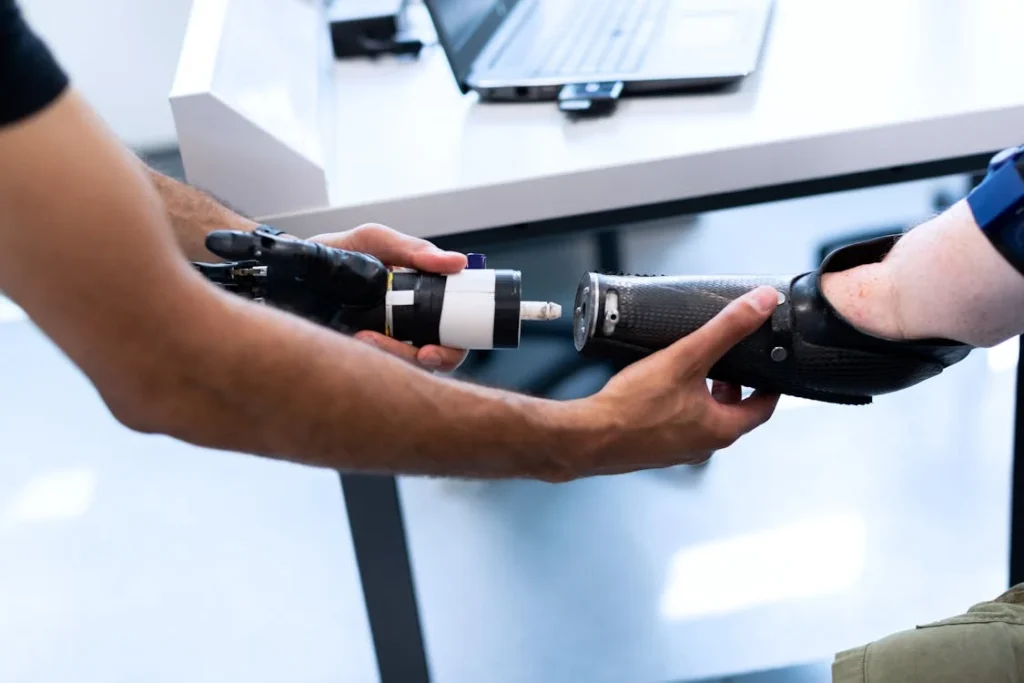
Smarter, More Intuitive Prosthetic Hands
Technology is making prosthetics feel more natural than ever. One of the biggest breakthroughs is AI-driven myoelectric control.
This technology uses artificial intelligence to learn from a user’s muscle signals. Over time, the prosthetic adapts, making movements smoother and more precise.
Another key development is haptic feedback, which allows users to “feel” what they touch.
Sensors in the fingertips send signals to the brain, restoring a sense of touch that was once thought impossible.
This technology is evolving rapidly, and by 2030, it could become a standard feature in bionic hands.
Customization Through 3D Printing
3D printing is changing the game in prosthetics. Traditional prosthetic hands can be expensive and time-consuming to produce.
But 3D printing allows for quick, affordable customization. Users can get a prosthetic tailored to their unique needs, whether it’s a lightweight design for daily activities or a durable one for sports and heavy-duty work.
Robobionics’ Grippy™ is a great example of how 3D printing makes prosthetics more accessible. It’s not just about affordability—it’s about giving users a device that fits perfectly and feels natural.
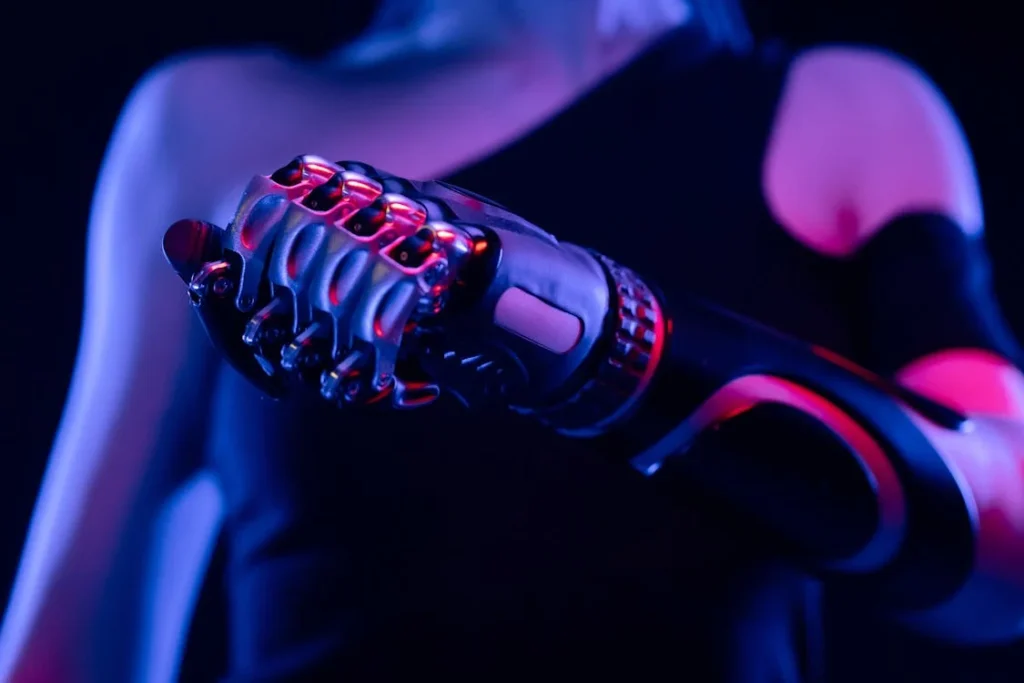
Smarter, More Intuitive Prosthetic Hands
Advancements in upper limb prosthetics are pushing the boundaries of what artificial limbs can do.
The focus is shifting from mechanical movement to intelligence, adaptability, and human-like interaction.
Prosthetic hands are no longer just tools; they are becoming extensions of the body, offering users control, comfort, and even sensory feedback.
AI-Driven Myoelectric Control
One of the biggest game-changers in prosthetic technology is artificial intelligence.
AI-driven myoelectric control is transforming the way users interact with their prosthetic hands.
These systems use sensors placed on the skin to detect muscle activity. The AI then processes these signals, learning the user’s movements and adapting to them over time.
The benefit of AI is that it makes prosthetic control more intuitive. Traditional myoelectric prosthetics require the user to consciously trigger specific muscle movements to operate the hand.
This can be tiring and takes a long time to master. AI, however, can recognize patterns in muscle activity and predict what the user intends to do.
The more the user wears the prosthetic, the better it understands their movement style, reducing the learning curve.
Future advancements could even integrate machine learning to allow prosthetic hands to improve their responsiveness continuously.
This would make daily tasks—like gripping a cup or tying shoelaces—feel far more natural.
The Rise of Haptic Feedback
Restoring a sense of touch to prosthetic hands has been a dream for decades. While early versions of bionic hands provided some level of movement, they lacked the ability to convey physical sensations.
This made it difficult for users to gauge pressure when holding objects, often leading to frustration and accidental drops.
Haptic feedback technology is solving this problem. By embedding sensors in the fingertips of a prosthetic hand, electrical signals can be sent back to the user’s nervous system, simulating the sensation of touch.
Some advanced systems can even differentiate between textures, helping users distinguish between rough and smooth surfaces.
By 2030, haptic feedback could become a standard feature in high-end prosthetic hands. Researchers are also working on integrating temperature sensors, allowing users to feel heat and cold.
This development could vastly improve the way prosthetic users interact with the world around them.
Brain-Controlled Prosthetics
While myoelectric control has been a breakthrough, the next step in prosthetic innovation is direct brain control.
Brain-machine interfaces (BMIs) are being developed to allow prosthetic hands to respond to thoughts, bypassing muscle signals entirely.
Early research in this field has shown promising results. Some experimental prosthetic arms already allow users to move their fingers by simply thinking about it.
These devices use electrodes implanted in the brain to capture neural signals and translate them into movement commands for the prosthetic.
The challenge is making this technology more accessible. Current brain-controlled prosthetics require surgery and extensive training, limiting their availability.
However, as non-invasive BMI technology improves, brain-controlled prosthetic hands could become a reality for a much larger number of users.
Customization Through 3D Printing
Personalization is becoming a priority in prosthetic development. No two users are the same, and a one-size-fits-all approach often leads to discomfort or limited functionality.
This is where 3D printing is making a significant impact. 3D-printed prosthetics allow for customization at a fraction of the cost of traditional manufacturing. Users can choose the shape, size, and even aesthetic design of their prosthetic hands.
This is especially beneficial for children, who need new prosthetics as they grow. Instead of waiting months for an expensive new limb, a 3D-printed replacement can be produced in a matter of days.
Robobionics has embraced this technology with Grippy™, a lightweight and ergonomic prosthetic hand that is both affordable and highly functional.
The ability to print custom prosthetics locally also means faster service and easier repairs, ensuring that users get the best possible experience.
The Future of Smarter Prosthetics
The next five years will bring even more refined versions of these technologies. Smarter prosthetic hands will learn faster, respond more naturally, and feel more like a part of the user’s body.
The goal is to move beyond mechanical function and create prosthetics that restore both movement and sensation seamlessly.
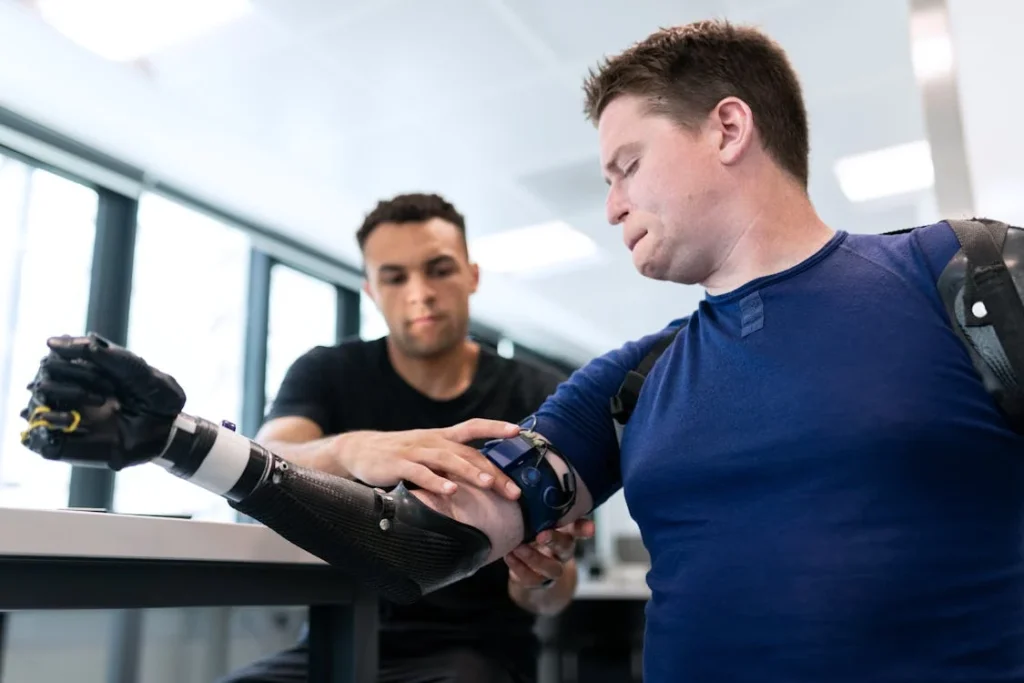
Accessibility and Affordability: Making Advanced Prosthetics Available to Everyone
As prosthetic technology advances, one of the biggest challenges remains accessibility.
Many of the most cutting-edge prosthetic hands are expensive, putting them out of reach for a large number of people who need them. In the coming years, there will be a strong push toward making high-quality prosthetics more affordable and widely available.
Innovations in materials, production methods, and distribution will play a key role in ensuring that no one is left behind.
The Cost Barrier and How It’s Changing
Traditionally, high-functioning myoelectric prosthetics have been prohibitively expensive. The complexity of the technology, combined with the customization needed for each user, drives up the cost.
This makes it difficult for many individuals, particularly in developing countries, to access the best prosthetic solutions. One way this is changing is through advancements in 3D printing and modular designs.
By shifting away from expensive imported parts and toward locally manufactured, easily customizable components, costs can be significantly reduced.
Robobionics has already taken steps in this direction with Grippy™, offering an affordable yet advanced solution for individuals in India and beyond.
Additionally, governments and organizations are increasingly recognizing the need for better funding and insurance coverage for prosthetic devices.
As awareness grows, we can expect to see new policies that make it easier for people to get the prosthetics they need without financial strain.
The Role of Open-Source Prosthetics
Another exciting trend is the rise of open-source prosthetic designs. These designs are freely available to download and modify, allowing individuals and organizations to 3D print prosthetic hands at a much lower cost.
This approach has the potential to revolutionize access to prosthetic technology, especially in remote or underserved areas.
While open-source designs may not yet match the functionality of high-end prosthetics, they are improving rapidly.
With advancements in AI, haptic feedback, and durable materials, open-source prosthetics could soon offer more sophisticated solutions at a fraction of the cost.
Expanding Distribution Through Localized Manufacturing
One of the biggest barriers to accessibility is distribution. Many prosthetic components are produced in a few specialized factories, often located in Europe or North America.
This results in long wait times and high shipping costs for users in other parts of the world.
A shift toward localized manufacturing is helping solve this problem. Companies like Robobionics are leveraging regional production hubs to reduce costs and speed up delivery.
By manufacturing prosthetics closer to where they are needed, users can receive their devices faster, with easier access to repairs and adjustments.
This localized approach also allows for better customer support. Prosthetic users often need adjustments as they adapt to their new limb, and having a local provider ensures they can get the necessary modifications quickly.
Affordability Without Compromising Quality
Reducing costs should never mean sacrificing quality. Some lower-cost prosthetic options in the past have been less durable or less functional than their high-end counterparts.
However, new manufacturing techniques are changing this. Advances in lightweight yet strong materials, such as carbon fiber composites and flexible polymers, are making affordable prosthetic hands more durable and comfortable.
AI-driven software is also helping to improve the design process, ensuring that even lower-cost prosthetics can be highly functional and tailored to the user’s needs.
The Future of Accessible Prosthetics
The next five years will likely bring a significant reduction in the cost of advanced prosthetic hands, thanks to smarter manufacturing, better funding programs, and global awareness efforts.
The goal is to ensure that no matter where someone lives or what their financial situation is, they have access to a prosthetic hand that restores their independence and quality of life.
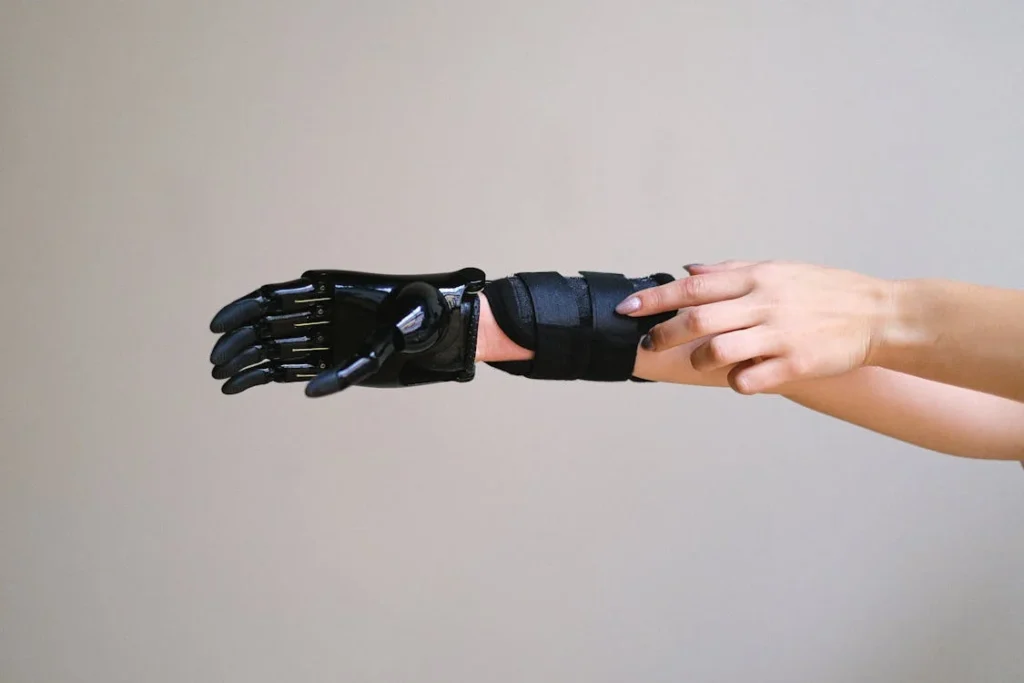
Rehabilitation and Adaptation: Helping Users Get the Most Out of Their Prosthetics
Getting a prosthetic hand is only the first step. For many users, the real challenge begins after receiving their new limb.
Learning how to use a prosthetic effectively, building confidence, and integrating it into daily life requires time, patience, and proper support.
Over the next five years, rehabilitation techniques will continue to evolve, making it easier for users to adapt to their prosthetic hands.
The Importance of Training and Muscle Conditioning
Myoelectric prosthetic hands rely on signals from muscles in the remaining part of the arm. However, if these muscles are weak or unused for a long time, controlling the prosthetic can be difficult.
This is why muscle conditioning is a key part of modern prosthetic rehabilitation. Physical therapy programs designed specifically for prosthetic users are becoming more advanced.
These programs focus on strengthening the muscles needed to operate the prosthetic, improving coordination, and reducing fatigue. The better a user’s muscle control, the smoother and more natural their movements with a prosthetic hand will be.
Some rehabilitation programs are incorporating electrical stimulation techniques, which help activate muscles and improve signal strength.
These techniques can speed up the adaptation process, allowing users to gain full control of their prosthetic in a shorter period.
Gamified Home-Based Rehabilitation
One of the biggest challenges in prosthetic training is making it engaging.
Traditional rehabilitation exercises can be repetitive and frustrating, leading some users to give up before they’ve fully adapted. To solve this, developers are turning to gamification.
Gamified rehabilitation involves using video games and interactive apps to help users practice their prosthetic control in a fun and motivating way.
These games are designed to encourage repetitive movement, improving muscle memory and coordination without feeling like a chore.
Some systems even use virtual reality, allowing users to interact with a digital environment while learning how to control their prosthetic hand. This can make rehabilitation feel less intimidating, especially for children or first-time prosthetic users.
Robobionics is actively integrating these innovative approaches, offering solutions that help users build confidence and skill from the comfort of their homes.
Psychological and Emotional Support
Adapting to a prosthetic is not just a physical challenge; it’s also an emotional one. Losing a limb can be a traumatic experience, and adjusting to a new way of interacting with the world takes time.
Many users experience frustration, anxiety, or even social stigma when first using their prosthetic hand. The future of prosthetic rehabilitation is placing a stronger focus on mental health support.
Counseling services, peer support groups, and online communities are playing a bigger role in helping users navigate the emotional aspects of their journey.
By connecting with others who have gone through similar experiences, prosthetic users can gain encouragement, advice, and reassurance.
AI-powered virtual coaching is another emerging trend. Some rehabilitation programs now include AI-driven assistants that provide real-time feedback and encouragement as users practice with their prosthetic.
This personalized support can help users stay motivated and track their progress.
Customizing Rehabilitation for Each User
Every prosthetic user is different. Some may need their prosthetic for work-related tasks, while others may be focused on regaining independence in daily activities.
Personalized rehabilitation plans are becoming more common, ensuring that each user receives training suited to their unique needs.
Data-driven rehabilitation is also gaining traction. Smart prosthetics equipped with motion sensors can collect data on a user’s movements, providing insights into their progress and areas for improvement.
These insights can help therapists adjust training programs for better results.
The Future of Prosthetic Rehabilitation
In the next five years, rehabilitation will become even more accessible, personalized, and engaging.
By combining physical therapy, technology-driven training, emotional support, and AI-driven guidance, prosthetic users will be able to adapt more quickly and with greater confidence.
The goal is to make prosthetic training a seamless and even enjoyable process, allowing users to focus on living their lives to the fullest.
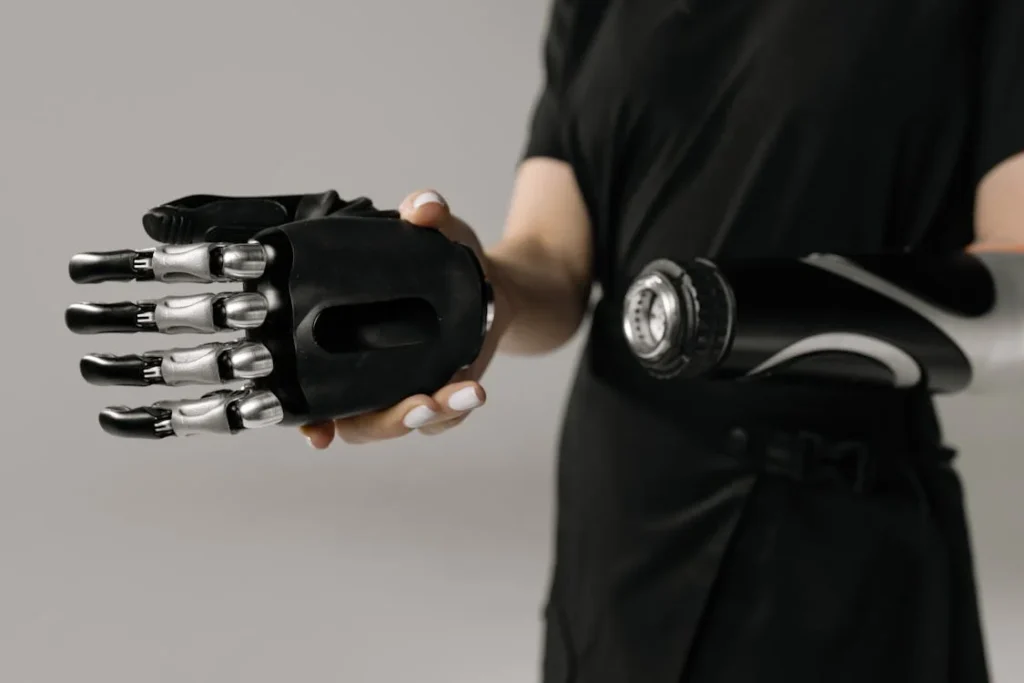
The Role of Robotics and AI in the Next Generation of Prosthetic Hands
Technology is advancing at a rapid pace, and nowhere is this more evident than in the field of prosthetics.
Robotics and artificial intelligence are transforming prosthetic hands from simple assistive devices into highly responsive and intelligent tools that enhance mobility, independence, and quality of life.
Between now and 2030, AI-driven prosthetics will become even more sophisticated, helping users regain natural movement with minimal effort.
Enhancing Precision with AI and Machine Learning
One of the biggest limitations of traditional prosthetic hands is the lack of fine motor control.
Many prosthetic users struggle with tasks that require delicate movements, such as picking up small objects or typing on a keyboard.
AI is helping solve this problem by improving the way prosthetic hands interpret muscle signals and translate them into movement.
Machine learning algorithms are now being integrated into advanced prosthetic systems. These algorithms analyze the user’s muscle patterns and learn from their movements over time.
As the prosthetic gathers more data, it becomes better at predicting the user’s intentions, allowing for smoother and more natural control.
This technology eliminates the need for excessive training and helps users feel more connected to their prosthetic hand.
Future advancements may even allow prosthetic hands to anticipate actions before the user fully initiates them, creating an almost seamless interaction between the brain and the device.
Combining Robotics with Sensory Feedback
While AI is improving movement, robotics is making prosthetics feel more natural.
Advanced robotic prosthetic hands are being designed with intricate joint structures that mimic the range of motion of a real hand.
These hands are becoming lighter, stronger, and more energy-efficient, making them easier to wear for extended periods. One of the most exciting developments is the integration of sensory feedback.
Traditionally, prosthetic users have had to rely on sight to judge how much pressure they are applying when holding an object. This can make tasks like gripping a fragile item or shaking someone’s hand difficult.
With the latest advancements in sensory technology, prosthetic hands are now being equipped with pressure sensors that send feedback to the user.
Some models use small vibrations to indicate how firmly an object is being held, while others use electrical stimulation to provide a more direct sensory experience.
These developments will allow users to perform everyday tasks with greater confidence and precision.
The Evolution of Self-Learning Prosthetics
Self-learning prosthetic hands are one of the most exciting trends to watch over the next decade.
These prosthetics are designed to adapt automatically to a user’s needs, adjusting their responsiveness and grip strength based on real-time data.
Future prosthetic hands could come with built-in AI assistants that monitor usage patterns and suggest adjustments to improve comfort and functionality.
For example, if a user frequently struggles with a particular movement, the AI could offer personalized training exercises to improve control.
This level of adaptability will help prosthetic users feel more at ease with their device, reducing frustration and making the transition to a prosthetic hand much smoother.
Bionic Limbs That Connect to the Nervous System
Perhaps the most groundbreaking advancement on the horizon is the development of prosthetic hands that can directly interface with the nervous system.
While brain-controlled prosthetics are still in the experimental stage, researchers are making progress in creating systems that allow prosthetic users to control their hands with thought alone.
By implanting tiny electrodes in the nerves of the residual limb, scientists have been able to establish a two-way communication system between the prosthetic and the brain.
This means users can not only control their prosthetic more naturally but also receive sensory feedback, allowing them to feel objects through their artificial hand.
While this technology is still in its early stages, it holds the potential to revolutionize upper limb prosthetics.
By 2030, we could see the first commercially available prosthetic hands that offer near-instantaneous neural control, bringing us one step closer to fully restoring lost limb function.
The Future of AI and Robotics in Prosthetics
The combination of AI, robotics, and neural integration is setting the stage for a new era in prosthetic technology.
Over the next five years, prosthetic hands will become smarter, more intuitive, and more capable of restoring natural movement and sensation.
As these technologies continue to evolve, they will break down the barriers that have traditionally limited prosthetic users, giving them more freedom, control, and independence than ever before.

The Role of Sustainability in the Future of Prosthetics
As technology advances, the prosthetics industry is also shifting toward more sustainable and environmentally friendly practices.
The production of prosthetic hands has traditionally relied on materials that are expensive and difficult to recycle.
However, new developments in sustainable materials and production techniques are paving the way for a future where prosthetic technology is not only more effective but also more eco-friendly.
The Shift Toward Biodegradable and Recyclable Materials
Most traditional prosthetic hands are made from plastics, metals, and electronic components that can be challenging to dispose of or recycle.
This leads to increased waste, especially as prosthetics need to be replaced or upgraded over time.
To address this issue, researchers are developing prosthetic components from biodegradable and recyclable materials.
New-generation bioplastics, derived from natural sources like cornstarch or sugarcane, are being explored as an alternative to petroleum-based plastics.
These materials can break down naturally over time, reducing environmental impact.
Similarly, recycled metals and composites are being used to create lightweight yet durable prosthetic structures, ensuring that fewer raw materials are needed for production.
In the future, prosthetic hands could be fully modular, meaning individual components could be replaced or recycled rather than discarding an entire device.
This approach would not only reduce waste but also make maintenance and upgrades more cost-effective for users.
Energy-Efficient and Solar-Powered Prosthetics
Most advanced prosthetic hands rely on batteries for power, which need regular charging and replacement.
This can create sustainability challenges, especially in areas where electricity access is limited.
To solve this, engineers are working on energy-efficient prosthetic designs that consume less power while maintaining high functionality.
One promising development is the integration of kinetic energy harvesting. Some experimental prosthetic hands are being designed to generate power from the user’s movements, reducing the need for external charging.
This would make prosthetics more self-sufficient and environmentally friendly.
Solar-powered prosthetics are another area of exploration. While still in the early stages, research is being conducted on prosthetic devices with built-in solar cells that allow users to recharge their devices using sunlight.
This could be especially beneficial for people in remote or off-grid locations, ensuring continuous prosthetic functionality without reliance on external power sources.
Sustainable Manufacturing and Local Production
Reducing the environmental impact of prosthetic production goes beyond just materials—it also involves rethinking how and where prosthetics are made.
Many prosthetic components are currently manufactured in centralized factories and then shipped worldwide, contributing to carbon emissions from transportation.
The future of prosthetic production will likely see a shift toward localized manufacturing using advanced techniques like 3D printing.
By producing prosthetic hands closer to where they are needed, companies can reduce shipping emissions, lower costs, and speed up delivery times.
This approach also allows for greater customization, ensuring that users receive prosthetics tailored to their needs.
Robobionics is already adopting this strategy, using regional production hubs to bring prosthetic solutions closer to the people who need them.
As this model expands, it will help make prosthetics more accessible while also promoting sustainability.
Reducing Electronic Waste Through Modular Design
Electronic waste is a growing concern, especially as prosthetic technology becomes more advanced.
With AI-powered and sensor-equipped prosthetics becoming more common, the challenge is ensuring that these devices remain functional and upgradable without generating unnecessary waste.
One solution is designing prosthetic hands with modular electronics. Instead of replacing an entire prosthetic hand when a single component becomes outdated or damaged, users could swap out individual parts, such as processors, sensors, or battery units.
This would significantly extend the lifespan of prosthetic hands, reducing both costs and environmental impact.
In the future, repairability and sustainability will go hand in hand. Companies that prioritize easy-to-repair designs and long-lasting materials will not only benefit users but also contribute to a more sustainable industry.
The Future of Sustainable Prosthetics
By 2030, the prosthetics industry will likely be much greener, with biodegradable materials, energy-efficient designs, and sustainable manufacturing becoming the norm.
These innovations will ensure that advanced prosthetic hands are not only functional and affordable but also environmentally responsible.
Conclusion
The future of upper limb prosthetics is bright. With advancements in AI, robotics, haptic feedback, and brain-machine interfaces, prosthetic hands will become more intuitive and responsive than ever before. At the same time, efforts to make these technologies more affordable and accessible will ensure that more people can benefit from them, regardless of their location or financial situation.
Rehabilitation is also evolving, making it easier for users to adapt through gamified training, muscle conditioning, and psychological support. Meanwhile, sustainability is becoming a priority, with new materials, energy-efficient designs, and localized manufacturing reducing costs and environmental impact.
Companies like Robobionics are at the forefront of these changes, developing innovative solutions that empower users and improve lives. As we move toward 2030, prosthetic hands will continue to evolve, not just as tools but as true extensions of the human body.
If you or a loved one is considering a prosthetic hand, now is the time to explore the possibilities. Book a free demo of Grippy™ today and experience the future of bionic hands firsthand.



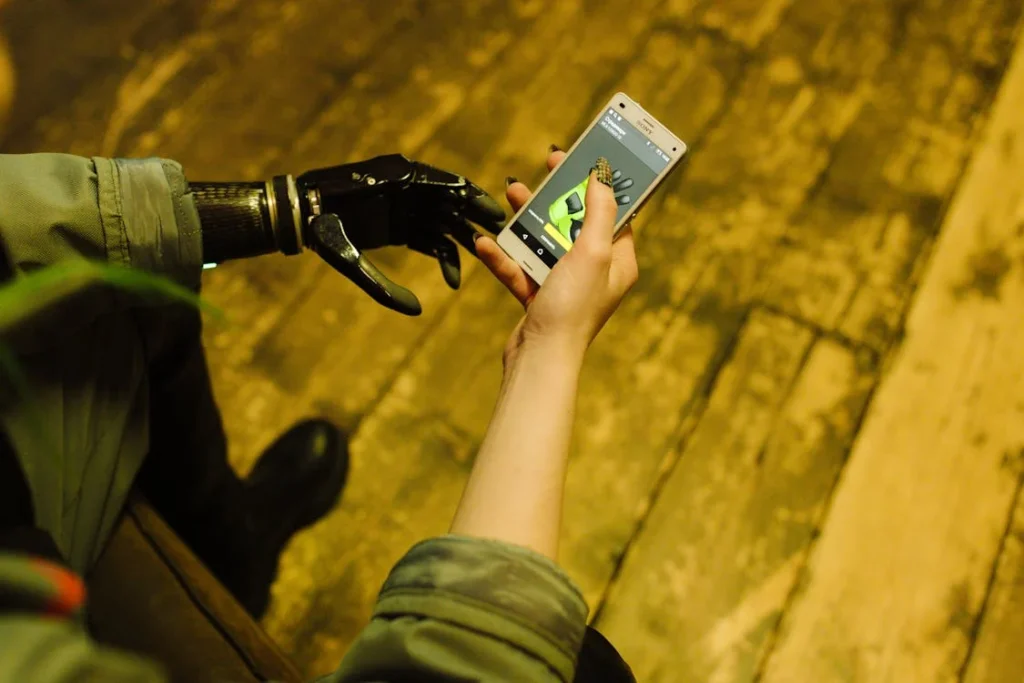
Pingback: Best Quality Prosthetics for Optimal Comfort & Function – Prosthetics Blog